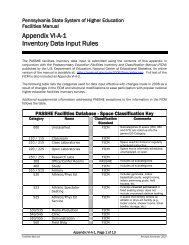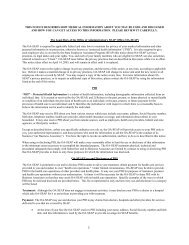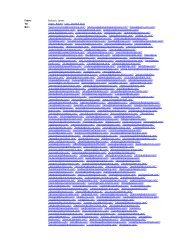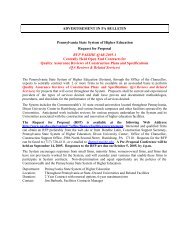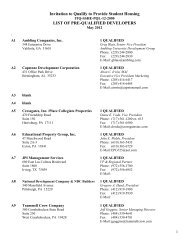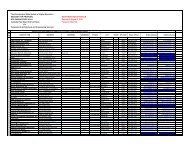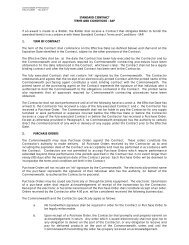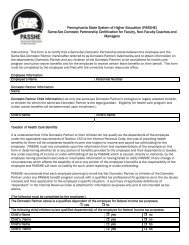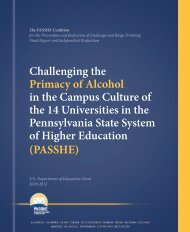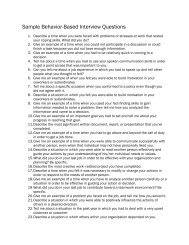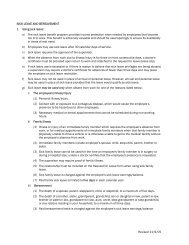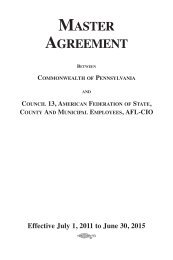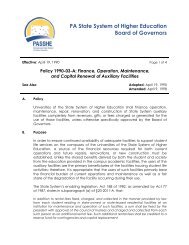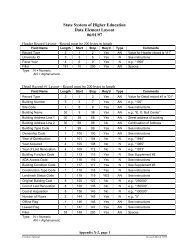BASICS Brief Alcohol Screening and Intervention of College Students
BASICS Brief Alcohol Screening and Intervention of College Students
BASICS Brief Alcohol Screening and Intervention of College Students
You also want an ePaper? Increase the reach of your titles
YUMPU automatically turns print PDFs into web optimized ePapers that Google loves.
OutcomesOn average, students who drinkheavily as freshmen tend to reportfew negative consequences over timeas the reasons for drinking diminishor change. However, those whoreceived <strong>BASICS</strong> reported fewer consequences<strong>and</strong> more rapid change.The risk period for young adults maythus be minimized through this briefintervention. Other independentstudies suggest that receivingpersonal feedback is a critical part <strong>of</strong>the <strong>BASICS</strong> program. Those receivinggeneral alcohol education withoutthe feedback did not fare as well asthose receiving <strong>BASICS</strong>.Changes in alcohol-use related negativeconsequences experienced by college studentsreceiving <strong>BASICS</strong> <strong>and</strong> comparison groupsNegative consequencesexperienced by students1.30.80.3-0.2Normative Comparison GroupHigh-Risk Comparison Group<strong>BASICS</strong> GroupBaseline 1 Year 2 Year 3 Year 4 YearNormative comparison group: students not involved in heavy drinkingHigh-risk comparison group: heavy drinkers not receiving the <strong>BASICS</strong>interventionTARGET POPULATION<strong>BASICS</strong> was designed for college students 18 to 24 years old who drinkheavily <strong>and</strong> have experienced negative consequences as a result. The programis not designed for students who are alcohol dependent, but it can beused as part <strong>of</strong> a stepped-care approach for assessment, advice, <strong>and</strong> referralto specialty care. <strong>BASICS</strong> has been evaluated with non–treatment-seekingstudents in large, traditional university settings but may be tailored for usewith young adults in other settings such as the military.BENEFITS• Increases students’ awareness <strong>of</strong> the risks associated with alcohol use• Fosters safer alcohol-use choices such as when, where, <strong>and</strong> how muchto drink• Young adults gain increased awareness <strong>of</strong> alcohol-impaired choices thatcan lead to health problems, social difficulties, <strong>and</strong>/or legal problemsHOW IT WORKSAs a harm reduction approach, <strong>BASICS</strong> aims to motivate students to reducerisky behaviors rather than focus on a specific drinking goal such as abstinenceor reduced drinking. <strong>Students</strong> can be identified through routinescreening or through referral from medical, housing, or disciplinary services.There are two 50-minute interviews. Before or after the first interview, thestudent receives a self-report questionnaire to complete. From the questionnaire<strong>and</strong> the first interview, information is gathered about the student’s—• <strong>Alcohol</strong> consumption pattern• Personal beliefs about alcohol• Underst<strong>and</strong>ing <strong>of</strong> social alcohol norms• Family historyThe second interview, which occurs approximately 1 week after the initialinterview, provides the student with—• Personalized feedback on myths about alcohol’s effects• Facts on alcohol norms• Ways to reduce future risks associated with alcohol use• A menu <strong>of</strong> options to assist in making changesIMPLEMENTATION ESSENTIALS<strong>BASICS</strong> can be implemented in a variety <strong>of</strong> settings, including universityhealth <strong>and</strong> mental health centers, residential units, <strong>and</strong> administrative<strong>of</strong>fices. Private <strong>of</strong>fices are needed for confidential interviews.SAMHSA Model Programs • http://model
Training <strong>and</strong> MaterialsTraining (or supervision by trained personnel) is recommended to implement<strong>BASICS</strong> <strong>and</strong> depending on staff experience, it can be completed in 1to 2 days. Trainees need interviewing skills, <strong>and</strong> many parapr<strong>of</strong>essionals caneffectively deliver the program. Training encompasses knowledge <strong>of</strong> alcoholuse among college students <strong>and</strong> specific clinical techniques such as nonconfrontationalinterviewing. The <strong>BASICS</strong> workbook, available throughGuilford Press, provides the information <strong>and</strong> charts needed for conductingthe interviews. The developers <strong>of</strong> <strong>BASICS</strong> can provide onsite <strong>and</strong> <strong>of</strong>fsitetraining.Evaluation <strong>and</strong> Technical AssistanceProgram implementation requires the development <strong>of</strong> assessment <strong>and</strong> feedbacktools tailored to the specific setting <strong>and</strong> population. The <strong>BASICS</strong> workbookprovides sample tools <strong>and</strong> additional information, <strong>and</strong> assistance can beobtained through consultation with the program developers. Several genericWeb-based forms for assessment <strong>and</strong> feedback are also available (e.g., e-chug.com <strong>and</strong> mystudentbody.com), which instructors can use to help developfeedback for students.PROGRAM BACKGROUND<strong>BASICS</strong> was developed based on two active areas <strong>of</strong> research in alcohol treatment:cognitive-behavioral group treatment <strong>and</strong> brief interventions in addictiontreatment. The developers <strong>of</strong> <strong>BASICS</strong> <strong>and</strong> their colleagues spent morethan 15 years developing <strong>and</strong> testing the efficacy <strong>of</strong> prevention programswith college students. The majority <strong>of</strong> students met the diagnostic criteria foralcohol abuse. Two studies showed that a 6-week alcohol-use prevention programfor groups <strong>of</strong> students had been effective but time consuming. Theprogram was based on cognitive-behavioral treatment <strong>and</strong> designed to challengemyths about the effects <strong>of</strong> alcohol <strong>and</strong> teach risk reduction. A comparisongroup received brief advice during a single supportive interview thatincluded assessment <strong>and</strong> feedback from a group leader. The students receivingbrief advice appeared to achieve similar effective results.TARGET AREASProtective Factors To IncreaseIndividual• Awareness <strong>of</strong> personal drinking patterns• Ability to challenge beliefs in myths aboutalcohol norms <strong>and</strong> effects• Awareness <strong>of</strong> personal vulnerability• Awareness <strong>of</strong> alcohol’s negative consequencesrelated to health, social, <strong>and</strong>/orlegal problems• Concern about social embarrassment as adeterrent to heavy drinking• Awareness <strong>of</strong> better <strong>and</strong> safer choices• Increased involvement in safe, alcohol-freeactivities• Awareness that moderate drinking can be asenjoyable as heavy, hazardous drinkingRisk Factors To DecreaseIndividual• Erroneous attitudes about heavy drinking• False information about alcohol absorption,metabolism, <strong>and</strong> blood alcohol effects• Belief that negative effects <strong>of</strong> alcohol “won’thappen to me”<strong>Brief</strong> interventions in addiction treatment typically include careful assessment<strong>of</strong> drinking patterns, risks, <strong>and</strong> symptoms, followed by empathetic advice tomake changes. Such brief interventions had been shown to be effective fordrinking behavior among adult heavy drinkers seeking treatment but had notyet been developed for alcohol-nondependent young adults.programs.samhsa.gov • 1 877 773 8546
HERE’S PROOF PREVENTION WORKSEVALUATION DESIGN<strong>BASICS</strong> has been evaluated with r<strong>and</strong>omized longitudinal designs. In thesestudies, student volunteers were recruited <strong>and</strong> assessed, then selected accordingto their drinking practices. <strong>Students</strong> who drank heavily were most commonlychosen, but students were also selected if they lived in a heavy-drinking settingsuch as a fraternity house. <strong>Students</strong> were then r<strong>and</strong>omly assigned to receive<strong>BASICS</strong> or not. In some studies, a control program was added in which studentsreceived some other preventive program. At a later date, all students werereassessed <strong>and</strong> the groups’ drinking practices were compared. In four r<strong>and</strong>omizedstudies, to date, students receiving <strong>BASICS</strong> reported less drinking <strong>and</strong>/orfewer negative consequences <strong>of</strong> drinking compared to those not receiving<strong>BASICS</strong>. In one study, differences were observed 4 years after the baselineassessment.PROGRAM DEVELOPERG. Alan Marlatt, Ph.D<strong>BASICS</strong> was developed with the support <strong>of</strong> research grants from the U.S.Department <strong>of</strong> Health <strong>and</strong> Human Services’ National Institute on <strong>Alcohol</strong>Abuse <strong>and</strong> <strong>Alcohol</strong>ism to Dr. G. Alan Marlatt at the University <strong>of</strong> Washington.Coinvestigators in the development <strong>of</strong> the first evaluation study were John S.Baer, Ph.D., <strong>and</strong> Daniel R. Kivlahan, Ph.D. Dr. Marlatt <strong>and</strong> his associates areclinical research psychologists who have focused on the development <strong>of</strong> innovativeprograms for addictive behaviors. They seek to broaden the base <strong>of</strong> healthservices for individuals with a range <strong>of</strong> alcohol- <strong>and</strong> drug-related problems.CONTACT INFORMATIONG. Alan Marlatt, Ph.D.Addictive Behaviors Research CenterDepartment <strong>of</strong> PsychologyBox 35125University <strong>of</strong> WashingtonSeattle, WA 98195Phone: (206) 685-1395Fax: (206) 685-1310E-mail: marlatt@u.washington.eduJohn S. Baer, Ph.D.S-116-ATCVA Medical Center1660 S. Columbia WaySeattle, WA 98108Phone: (206) 768-5224Fax: (206) 764-2293E-mail: jsbaer@u.washington.eduRECOGNITIONModel Program—Substance Abuse <strong>and</strong> MentalHealth Services Administration, U.S.Department <strong>of</strong> Health <strong>and</strong> Human Serviceshttp://modelprograms.samhsa.gov • 1 877 773 8546



